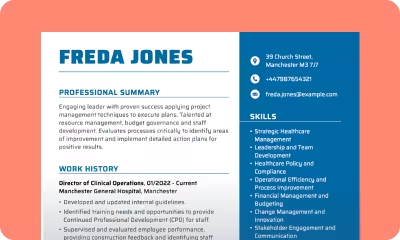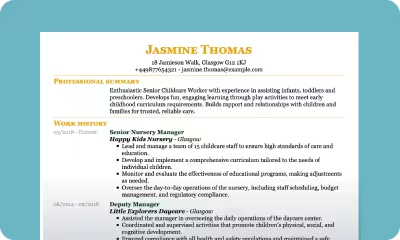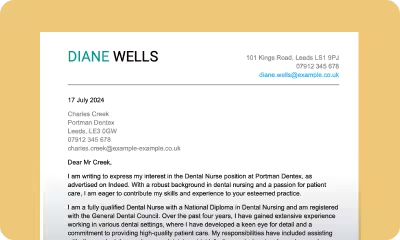- Our customers have been hired by : *Foot Note
If you are applying for jobs in the motor industry, an automotive engineer CV sample can give you valuable guidance as you set out your work experience and skills. For the best results, you should tailor your CV to the exact job you want, both in the information you supply and in the way you format the page, and that’s where an automotive engineer CV examples can help your application shine.
The sample below has been researched and written with automotive engineering positions in mind. With the right CV, you will be helping employers to find you, as well as helping yourself to find a great job. We’ve topped that off expert guidance about the entire process, giving you everything you need in one place:
SEARCH ALL CV EXAMPLES
Automotive engineer CV sample
Joanna Dylan
246A Lawrence Drive, Bradford BD7 4PP
07912345678
Joanna.Dylan@example-example.co.uk
Professional summary
Skilled engineering professional specialising in building and optimising mechanical designs. Collaborates well across disciplines for successful development and implementation.
Work history
March 2019 – Current
M. M. H. Ltd. – Bradford
Automotive Engineer
- Consulted on engineering projects, offering mechanical perspective to different disciplines in a collaborative environment.
- Used correct methodology to calculate parameters and make correct design choices.
- Sourced sustainable materials for designs, reducing environmental impact.
February 2016 – February 2019
E.D. Motors – Bradford
Automotive Engineer
- Analysed technical designs and prototypes at each stage of product development lifecycle.
- Inspected completed equipment for compliance with codes, design specifications and quality standards.
- Calculated tolerances and loads to optimise mechanical designs.
- Evaluated operation and performance of equipment, components and systems.
Skills
- Technical drawing preparation
- Trend analysis
- Client coordination
- Production support
- Root Cause Analysis
- Performance Optimization
- CAD
- Project management
Education
Bradford University Bradford – 2013
Bachelor of Science Mechanical Engineering
Which format is right on a CV for automotive engineer applicants?
When writing an automotive engineer CV, the first thing you need to decide on is the format. In short, this refers to the structure of your CV – what you include, where you include it, and even how you include it.
Broadly speaking, you’ll want to use the reverse-chronological CV formats. The main body of this CV is made up of your work history, which is what UK recruiters are most interested in. It comes after your contact details and personal statement, and is followed by a brief skills list and education.
The most popular alternative to this format is a skills-based CV. For this, the skills list is much more exhaustive, making your competencies the focal point. It’s ideal for candidates without much or any experience. However, that’s not typically suitable for automotive engineers, where experience is key.
Some other formatting tips include:
- Use bullet points to list duties from each job role to keep things concise.
- Keep your CV within one or two pages at most. You can tweak things like the font size to make your CV fit better.
- That said, keep your font sizes within 10-12 for paragraph text and 14-16 for headings to keep it readable.
- Finish your CV off with a slick, professional design rather than simple sending as a bland black and white Word document.
Top tips for automotive engineer CV writing
Be clear about what you do
Automotive engineering is broader than it sounds. It can cover different types of vehicles, like bikes, cars, or trucks. But it can also have different areas of specialism like design or testing, for example. Recruiters will want to know exactly what you do so they can see if you’re a good fit for the role, so make sure you mention any specific fields of expertise in your CV. Feel free to list multiple if applicable though..
Don’t get too technical
As an automotive engineer, a lot of what you do will undoubtedly be very technical. But recruiters aren’t always experts in the jobs they’re hiring for. While it might seem like jargon and acronyms will showcase your expertise, they could actually remove all meaning from what you’re saying. Use plain English wherever possible and list the full term for any abbreviations you do use.
Add an interests section
Interests sections are recommended if you have relevant hobbies or pursuits outside of the work. That is often the case for automotive engineers. You can add this section at the end of your CV, with 2-3 sentences about your automotive interests to demonstrate your passion and motivation for the job at hand.
Write a cover letter too
Another good way to distinguish yourself is by adding a cover letter to your application. Going beyond a few sentences in an email, this one-page document expands on the points mentioned in your CV and how they make you a great fit for the job. You can talk about specific achievements in more detail or mention modules on your degree, for instance, which wouldn’t be suitable for a CV.
Don’t send the first draft!
Attention to detail is vital in the automotive industry. You wouldn’t want your CV to let you down on that front. Before sending your CV, make sure there are no errors – whether it’s grammatical mistakes, typos, or missing information. As well as reading your CV back, you can get someone else to check it for you and run it through a spellchecker.
How to write a CV for an automotive engineer
Writing your automotive engineer CV doesn’t have to be daunting. The best advice is to break it down and tackle it section by section. Some people like to start with the personal statement and work through in the conventional order. However, you might find it easier to start with education and work history, then use that to create a skills list and reflect everything in your personal statement.
Ready to get started? Keep reading for step-by-step advice on how to write a CV:
- Adding contact details to your automotive engineer CV
- Start your automotive engineer CV with a personal statement
- Adding work experience to your automotive engineer CV
- Automotive engineer CV skills
- Outlining education on an automotive engineer CV
Adding contact details to your automotive engineer CV
First things first, you’ll want your contact details right at the top of your automotive engineer CV. Putting them anywhere else will make it harder for recruiters to find them – and you definitely don’t want to discourage them from getting in touch.
Here’s what you should list on your CV:
- Your name
- Your address
- Your phone number
- Your email address
Example of contact section for an automotive engineer CV
Jane West
36 Eton Road, Slough
07789 998 889
janewest@fmail.com
Start your automotive engineer CV with a personal statement
Sitting just below or beside your contact details, your personal statement will give recruiters their first impression of your CV. As such, it’s definitely not something you want to rush through.
Also known as a professional summary, this section should showcase your most important selling points to recruiters. That includes your years of experience, any specialisms within automotive engineering, and some key skills or qualities that set apart.
However, one of the most common mistakes of personal statements is that they’re too long. As such, recruiters won’t read them properly, and won’t take in your most important qualities. It’s well worth spending a little extra time to condense your personal statement into three or four easily digestible sentences.
Example of personal statement for an automotive engineer CV
Automotive engineer familiar with CAD software, as well as analytics software and databases. A good team player and communicator, able to work with clients and colleagues at all levels. Experienced in project management, budget control, and working to deadlines.
OR
Experienced candidate with 15 years in the automotive industry. Specialises in vehicle testing with impeccable attention to detail. Familiar with the latest testing requirements and health and safety standards. Able to work independently as part of a wider production line.
Adding work experience to your automotive engineer CV
Experience in the automotive industry is invaluable for your CV. By detailing what kind of work you’ve done in the past, you can show recruiters what you’re capable of if they do hire you. But you’ll also demonstrate your career progression and some of your best qualities in the process.
basics you’ll need to include are the company name, job title and dates of employment. For each role, you can then write a summary of your main responsibilities. However, it’s typically best to include a bullet-point list of duties. This allows you to add more distinction to your different skills and pack more in with concise, short sentences.
If you’re applying for an entry level automotive engineer role or apprenticeship, you might not have much relevant experience. Remember, volunteer roles and short placements still add lots of value. Alternatively, jobs in admin, retail, and so on, can show your transferable skills like teamwork, digital literacy, and organisation.
Example of work experience for an automotive engineer CV
Volunteer scrutineer, Slough Motor Club, Slough (August 2013 – present)Senior Archivist | Waterfront Museum | Cardiff – June 2010 to present
- Inspecting cars to ensure they meet race standards
- Analysis following crashes and accidents
- Issuing documentation
Automotive intern, Cobham Motors, Cobham (May 2014 – March 2015)
- Project management
- CAD
- Inspecting and testing vehicles
- Recording information and writing reports
Automotive engineer CV skills
You’ll no doubt touch upon a few skills and qualities in your personal statement and work history. However, it’s also well worth having a dedicated CV skillss section that lists your main capabilities. This will eliminate any doubt for recruiters, and ensure they notice your top skills even if they’re just skim-reading.
So, what should you include? We recommend mixing in both hard, technical skills and soft, transferable qualities. Here are our top picks to give you some ideas.
Essential skills for an automotive engineer
- BSc in Mechanical Engineering or similar
- CAD software
- Project management
- Vehicle design, development and testing
- Attention to detail
Desirable aptitudes to set you apart
- Driving licence
- Commercial awareness
- Well-organised
- Communication skills
- Maths and analytical skills
Outlining education on an automotive engineer CV
As a minimum, automotive engineers need to know how vehicles work
That could be the practicalities and physics of a car’s design or the technicalities and chemical considerations in the engine. This kind of knowledge is usually acquired through a degree – which is why it’s so important to list yours on your CV. It provides a strong foundation for the experience and expertise outlined in the rest of your CV.
Your higher education can be complemented by further education like A levels or a diploma. You may also want to include your high school education like GCSEs if they’re within the past decade. Whatever you include, there are some basic details you should list:
- Institution name
- Qualification level
- Study dates or graduation date
- Course or qualification title
Example education section for an automotive engineer
BSc in Mechanical Engineering, University of Windsor 2022
A level – Mathematics (A), Further Mathematics (B), Physics (A) East Sussex College 2019
Seven GCSEs including English, Mathematics, Information Technology and Design and Technology Romford High School 2017
Your automotive engineer CV questions answered
What does an automotive engineer do?
Automotive engineers have a wide range of responsibilities, including:
- Designing and developing new vehicles
- Overseeing and project managing the manufacturing process
- Testing vehicles for safety and performance
- Assisting with marketing and sales
- Managing budgets, schedules, resources, and other staff
What qualifications do I need to be an automotive engineer?
Most automotive engineer jobs require a degree in a relevant subject, such as:
- Mechanical engineering
- Automotive engineering
- Electrical engineering
What’s the best length for an automotive engineer CV?
1-2 pages is the best length for your automotive engineer CV. If you can briefly summarise your experience and skills on one page, that’s ideal for recruiters. More experienced candidates may require two pages, even with the most concise approach.
hat is the best design for an automotive engineer CV?
Here are some design must-haves for your automotive engineer CV:
- Use colours sparingly for your name, headings, or design features like page breaks and margins.
- Add subheadings so recruiters can find what they’re looking for easily.
- Use a clear, simple font like Arial or Calibri with conventional sizes.
- Make sure your CV fits the page by tweaking things like section spacing and font size. If it’s just over a page, cut it down to fit on one. If it’s almost two, add a bit of spacing so it fits nicely.
Steer your automotive engineer CV in the right direction
This automotive engineer CV sample is one of a wide range of tools and guides available for your use, so you can build your CV with our help. As well as getting inspiration from our CV examples, you can drive your CV forward with our easy-to-use online builder. Get the wheels in motion with a professional CV templates, then fuel up your CV with pre-written content for automotive engineer duties and skills.
*The names and logos of the companies referred to above are all trademarks of their respective holders. Unless specifically stated otherwise, such references are not intended to imply any affiliation or association with myperfectCV.




